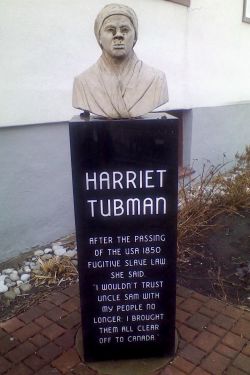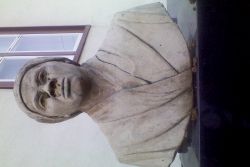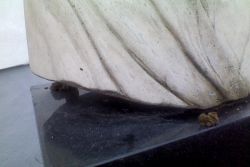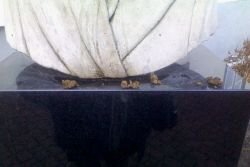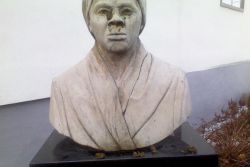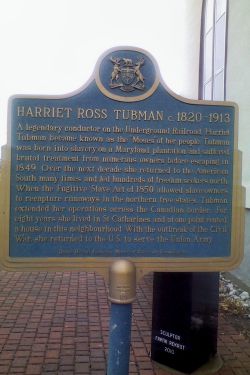Halifax Media Co-op
News from Nova Scotia's Grassroots
A Visit to St. Catharines 2013
St. Catharines' legacy as haven for fugitive slaves is undercut by desecration of Harriet Tubman Memorial Bust (Salem Chapel B.M.E. Church)
A lone woman stands ankle deep in swamp water, surrounded by darkness. She stands in the marshes of Maryland singing in a clear strong voice, “I’m bound for the Canaan land…I’m bound for the Canaan land…If you won’t come, don’t hinder me…I’m bound for the Canaan land.” They hear her voice on the wind and vapors, those who have waited all their lives to hear that singular voice. That voice, breaking the chains of bondage. That voice, sending a thrill of freedom, coursing through the blood. They hear it, and answer the call of their Moses; a Moses who is black, like the darkness surrounding her, and a woman.
At the age of eleven, I discovered the world of Harriet Tubman. While I’d heard of slavery from my father (a card carrying Black Panther Party member, who initiated Black History curriculum in the Philadelphia Public Schools), and while I knew the great exploits of African-Americans like Charles R. Drew, Thurgood Marshall, Mary McLeod Bethune, and Angela Davis, it wasn’t until I picked up a children’s book on the life of Harriet Tubman that I was able to wrap my young mind around what slavery was, and why the subsequent accomplishments of Black folk like George Washington Carver, Mary Church Terrell, and W.E.B. Du Bois were so extraordinary, and consequential.
On the morning of Thursday 12/5/13, I found myself on Go Transit taking a jaunt from Toronto, for a self-guided Underground Railroad (UGRR) site-seeing tour of St. Catharines and Niagara Falls. As a Fulbright researcher examining the UGRR as it relates to Atlantic Canada and Quebec, I came to Ontario for comparative study of its many UGRR sites. To that end, my principle focus in St. Catharines was Salem Chapel B.M.E. Church, down town in an area once known as Coloured Town, due to the concentration of escaped slaves looking to reside in a place of true liberty.
The church was close enough to the bus station, that I could walk, examine the façade and any memorial literature/plaques on the grounds, and still make it back for my bus to Niagara Falls. Not being familiar with the layout of downtown, I wanted to be certain not to lose time by getting turned around. I met a charming older lady walking in the direction of what I thought was Geneva Street. I confirmed with her, I was headed the right way, and we decided to walk together.
“I’m heading to Salem Chapel Church. You know…the one where Harriet Tubman was a member. She lived in St. Catharines for ten years.”
“Oh? Did she now?”
“You know Harriet Tubman?”
“You know I’ve been here three years already, but I don’t really know as much as I should.”
We walked a few more spaces, and I gave my new friend a very brief history of Harriet Tubman, and why St. Catharines should be honored she’d called it home. I was feeling pretty good. Felt, well…St. Catharines was a good choice as a first excursion on my self-guided tour.
I studied the entrance way, noting how it had been maintained. I walked across the street and took a photo, then glanced around one side, and noticed a type of park, very tiny, but quite peaceful and nice. As there was no gate, and no caretaker, I walked in and was startled to find a large bust on a pedestal, kind of “catty-corner” to the entrance, but well within the park, facing away from the entrance, towards the interior. As I expected, it was of Harriet Tubman. It looked to be of white clay, and was on a dark pedestal, tall enough that the head of the bust was level with my own. It was created by sculptor Frank Rekrut, and was dedicated September 13, 2010.
I looked at the face eagerly, then totally confused, and finally appalled. What I initially thought was dirt, or mud, turned out to be dog excrement! Someone had taken dog feces and plugged up the nostrils, the eye sockets, and the mouth of the statue, and then left huge clods of it all around the base of the bust. The time and intention of that kind of concentrated hate stunned me. The power and beauty of Harriet Tubman’s features seemed to scream out, and were even magnified by the defacement. Although I wanted to look away (I was literally nauseated), it was as if my eyes were glued to the scene. Timidly, I pulled out my phone and took a full length picture, then quickly turned away, and walked back towards the bus station.
But, the humiliation would not let me escape. Halfway to the bus station, with only fifteen minutes to catch my connection to Niagara Falls (a connection I could not afford to miss), I found myself turning on my heels, and walking back to the church and the desecrated face of Harriet Tubman. I kept thinking this is 2013! 2013! Almost 2014! I should not be seeing this. This is Canada! The Promised Land! Harriet Tubman brought people here through tears, blood, and sweat, racing just ahead of the blood hounds and the lash, with a $40,000 combined bounty on her head, to be taken dead or alive. A lone woman, barely five feet tall, traveling in winter because the nights were longer, braving the cold, wind, and gales, wading and fording icy rivers and streams – all to get to the Promised Land. Oh Canada!
When I arrived back in front of the bust, I whipped out my phone and started taking pictures in earnest. I got close ups and long views. All my shock and timidity gone. I saw a couple of phone numbers posted on the church doors. I phoned them both, leaving a lengthy message on one, but found the other, not in service. I tried again, and verified the number as it was posted to be sure I’d not misdialed. Once I realized I’d done all I could do, I raced back to the station and was fortunate to find my Niagara connection waiting with doors open. I paid my fare, then sat in a quasi-stupor for the entire ride, hoping this was not a foreshadowing of the rest of my UGRR experience in Ontario.
Many who read this article may not understand my despair at seeing a monument to Harriet Tubman so ill used. Some, surprising as it may seem, probably don’t even know who Harriet Tubman was/is, and why she’s significant for this time, and for all time, in Canadian/U.S. history, and global history. So, with that in mind, I ask your indulgence as I attempt to concentrate a behemoth life into a few paragraphs.
Araminta [Minty] Harriet Ross Tubman Davis, known to us as Harriet Tubman, was born between 1820-25, and died March 10, 1913. Her near century of living encompassed: Denmark Vesey’s uprising (1822), Nat Turner Rebellion (1831), Amistad ship rebellion (1839), Fugitive Slave Law [Bill] (1850), John Brown Pottawatomie Massacre (1856), John Brown forcibly liberating Missouri slaves (1858), John Brown’s raid on Harper’s Ferry (1859), U.S. Civil War (1861-1865), Emancipation Proclamation (1863), Lincoln’s assassination (1865), Passage of the 13th/14th/15th Amendments (1865/1868/1870), Reconstruction (1865-1877), Compromise of 1877, Jim Crow, dawning of the 20th century, and the sinking of the Titanic (1912).
Escaping slavery from Dorchester County, Maryland in 1849, she returned south as a conductor on the Underground Railroad, liberating an estimated 300 slaves. With a combined bounty of $40,000 on her head (dead or alive), she took her charges to Canada, carrying a gun and a deep faith in God. She was called Moses, and in her own words, “…never lost a passenger, and my train never jumped the track.” Although illiterate and plain spoken, she was the confidante of Presidents, abolitionists, writers, and poets. During the U.S. Civil War, she worked as a spy, a cook, a nurse, and the first woman to lead an armed expedition during the war, liberating over 700 South Carolinian slaves in the Combahee River Raid. Rarely paid, she did not receive her Army pension until 1899, when she was almost 79 years old. She founded the Harriet Tubman Home for the Aged, where she retired. The nation that refused to pay her for war service, buried her with full military honors at the Fort Hill Cemetery in Auburn, New York in 1913.
Upon liberating her family, they settled in St. Catharines, Ontario for ten years, where, between Underground Railroad missions, Harriet was an active member of the Salem Chapel B.M.E. Church, a vital part of the St. Catharines’ community. St. Catharines became a haven for escaped slaves.
After reading this, some of you may ask, “But that’s U.S. history! Why should we in St. Catharines, or in Canada be proud of Harriet Tubman?” Because, like it or not, Canadian history and the
history of the U.S. are inextricably linked, like an enmeshed “Slinky,” the coiled toy that once tangled, was literally locked forever. Canada would be a very different place if people like Harriet Tubman had not broken the shackles of U.S. slavery. More than likely the “peaceable kingdom” would be a lot less peaceable. Champions for justice anywhere are champions for justice everywhere. Cliché? But, true. And, we all benefit as a result. The global community benefits.
If you don’t believe this, then think on Mandela, think on Mohandas Gandhi, think on Malala Yousafzai, who took a bullet in the head for the sake of education for women and girls in Pakistan, or Ai Weiwei, the brave artistic genius who’s put his life on the line, taking on social injustice in China. Harriet Tubman was the Dr. King or the Malcolm X of her generation, and she lived in your home for ten years. For ten years, you had the honor of ownership, and it’s an honor you can claim, and take hold of, with pride, forever.
I think it’s important to mention, the desecration of the Harriet Tubman Memorial Bust was not a one-time occurrence. In my trouble-shooting, I was stunned to learn this was the third time it had been vandalized. Both times, previously, it had gone unreported to police. Why? Perhaps fear of reprisal; fear of further, more severe damage either to the statue, or the church, itself.
As a guest in Canada, as someone who’s here as an independent researcher examining the Underground Railroad relating to the Maritimes and Quebec, I feel awkward and uncomfortable having to write this article. Yet, sometimes it takes an outsider to throw an objective light on a situation/circumstance cloaked by covert racism, embarrassment, or fear. My goal is to shine such a light so both Canadians and those in the U.S. appreciate the richness of their collective legacy.
The site for the Halifax local of The Media Co-op has been archived and will no longer be updated. Please visit the main Media Co-op website to learn more about the organization.
